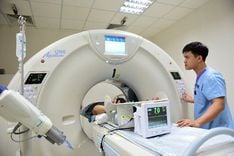This is an automatically translated article.
Posted by Specialist Doctor II Bui Le Phuoc Thu Thao - Radiotherapy Doctor - Oncology Center - Vinmec Central Park International General Hospital. The doctor has nearly 15 years of experience in direct treatment of cancer patients, especially radiation oncology and care for terminal cancer patients, palliative care and pain relief.The dose-modulated radiotherapy technique IMRT allows irradiation of a higher radiation dose to the tumor while reducing the dose below the threshold to healthy organs, thereby providing better treatment results and reducing side effects. compared with conventional techniques.
1. IMRT . dose modulated radiotherapy
IMRT is an advanced radiotherapy technique that uses a linear accelerator to deliver a precise dose of radiation to the tumor or volume to be treated. This technique uses reverse planning software to divide the projection fields into many small beams (beamlets) and modulate and control the intensity of these small beams to ensure the correct dose distribution according to the pattern. requirements of the treatment volume.Process of dose-modulated radiotherapy:
Step 1: Doctor consults to determine treatment protocol Step 2: Immobilize patient, simulate CT scan. The simulated CT image of the patient is transferred to the computer planning system Step 3: The radiologist determines the treatment volumes and healthy organs on the simulated CT image, combined with the MRI image or PET/CT . Step 4: Physical engineer and doctor together discuss and plan treatment for the patient. The number of projection fields, projection angle, MLC movement speed are automatically optimized by the computer by reverse planning. Step 5: Physical engineer validates pre-treatment plan Step 6. Establish patient position on treatment table Step 7: Digital X-ray or cone-beam tomography (Cone system) Beam CT is integrated on the radiotherapy machine) which helps to ensure the exact location of the radiation volume before each treatment beam (image-guided radiotherapy). Compare the digital X-ray image or electronic portal image (EPI) of the patient before treatment with the image at the time of treatment planning and simulation, and adjust the position – position of the patient to ensure that the patient's position during treatment is exactly the same as the position in the planning simulation with the allowed error. Step 8: Record the patient's skin surface at the treatment site, connect to the OSMS optical patient positioning system, which is capable of accurately determining the patient's position and immediately stopping the beam if the patient deviates. from the treatment site. Transmit patient treatment, monitor the patient through the camera screen and monitor the parameters on the treatment screen. During the treatment, the patient does not feel any pain or any discomfort. The duration of each dose-modulated radiotherapy session is 15-20 minutes. Typically, a course of radiation therapy using the IMRT dose-modulated radiotherapy technique lasts from 5 to 7 weeks, depending on the type of disease requiring radiation therapy.
2. Advantages of dose-modulated radiotherapy

IMRT dose-modulated radiation therapy allows the physician to direct the most and precise beam of radiation at the tumor, while the protected organs and surrounding healthy organs receive the radiation dose least and best protected.
The usual cases of radiation therapy cause some side effects that can reduce the quality of life due to the unwanted effects of radiation. The advent of dose-modulated radiotherapy (IMRT) was born to help solve this problem.
Therefore, intensity-modulated radiation therapy helps to increase the ability to kill tumors, while reducing the side effects of radiation therapy, and improving the quality of life for patients. However, because there is a huge dose difference between the treatment volume and surrounding healthy tissue, it requires precision in the treatment process and needs to be combined with radiotherapy under image guidance.
3. Disadvantages of dose-modulated radiotherapy
Patients may appear some side effects such as fatigue, loss of appetite, nausea, dermatitis, mucositis, digestive disorders, urinary disorders. Most of these side effects were mild and reversible after 1 to 2 weeks of treatment.
4. Why choose dose-modulated radiation therapy at Vinmec?
Currently, the dose-modulated radiotherapy technique has been applied at Vinmec Central Park Hospital, which has confirmed the strength of radiation therapy for head and neck cancer, breast, esophagus, lung, stomach, rectum, and cervical cancer. by providing successful treatment outcomes for hundreds of cancer patients.Here owns radiation therapy techniques from basic to advanced techniques in the world such as radiation therapy VMAT, SRS, SBRT, 4D - Synchronized breathing,... creating a breakthrough and Leading in high-tech radiation therapy in Hanoi as well as across the country:
Dose-modulated radiation therapy is applied in the treatment of a variety of diseases, in which the strength is head - neck, breast, esophageal cancer , lung, stomach, rectum, cervix 20 scientific studies have been published in the National Journal of Cancer and Radiation Therapy, showing results equivalent to those of Japan and the US. Specifically: After radiation therapy, the 3-year survival rate for patients receiving VMAT radiation therapy for head and neck cancer reached 87.5% - equivalent to that in Japan and the US Most patients are satisfied with the quality of treatment and Services at Radiotherapy Center Highly qualified, experienced, well-trained staff at home and abroad, dedicated to patients.
Please dial HOTLINE for more information or register for an appointment HERE. Download MyVinmec app to make appointments faster and to manage your bookings easily.














